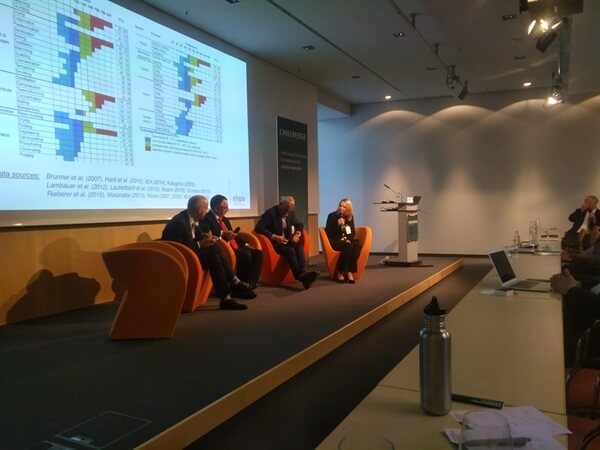
On 15th of October 2018, a panel debate on large heat pumps for industrial processes was organized during the Chillventa Congress, closing the homonym trade exposition. The panel, moderated by Thomas Nowak (European Heat Pump Association), gathered together industry representatives: Dr. Veronika Wilk (Austrian Insitute of Technology), Eric Delforge (Mayekawa) and Alexander Cohr Pachai (Johnson Controls), discussing the reasons for the up to now underdeveloped market segment. DryFiciency, an Innovation Action project funded by Horizon 2020 organised in collaboration with EHPA, was mentioned as an important vector to help energy-intensive industry to reach high energy efficiency and CO2 reduction.
Research and practical applications show increasingly clear that large, high temperature heat pumps are fit for purpose to provide heating and cooling to industrial applications and energy districts. ‘‘The rich body of case studies presented during the day confirms that the large heat pump technology is ready to be deployed in a much larger extent across industrial applications Europe-wide’’, Thomas Nowak, EHPA, stressed.
Despite the growing figures of the market, there was a wide agreement that the economic potential is far from being used. Panelists addressed different issues, concerning mainly:
Veronika Wilk (AIT) remarked that “to overcome the knowledge gap and provide security to decision makers, research projects like DryFiciency prove to be very valuable”. She explained that in DryFiciency project, research, component manufacturers and users of technology (Agrana starch, Wienerberger Bricks) cooperate to re-design their respective drying processes and to develop and test specific heat pump solutions in concrete real-life production processes.
Reinforcing this idea, Eric Delforge (Mayekawa) stressed out the need for the industry to have a better strategy to communicate benefits and applications of Heat Pumps both to engineering students and graduates. In his opinion, a ‘’heat pump university’’ could be a helpful body to disseminate the know-how.
Participants agreed that it was largely not understood that all cooling / refrigeration (providing temperatures below 0°C) processes were providing waste heat “for free” and presenting this joint opportunity could not only help improving the energy but also the economic efficiency of heat pump deployment. New consulting approaches and business models benefiting from that integration were deemed necessary.
Opportunities for a technology change in many sectors are coming from the end of the life-cycle of different manufacture technologies and from EU regulations, such as the F-gas phase down and the EU emission trading scheme. However, more efforts from policy makers were required both form panelists and audience. In particular, legislators should address issues like: low prices for the use of fossil energy, lack of CO2 price, still existing fossil energy subsidies.
Alexander Cohr Pachai (Johnson Controls) pointed out the need to speed up the process to reach the goal of a decarbonized society in 2050: “Considering the slow speed of change in industry, 2050 is really tomorrow, while for decision makers, it seems light years away. Basing investment decisions on existing fossil technologies would thus have to be considered a significant risk of stranded assets and non-compliance with forthcoming legislation”.
Author:
Alfredo Salmaso
Communications assistant
European Heat Pump Association
More information on DryFiciency:
Project Coordinator
Veronika Wilk
AIT Austrian Institute of Technology GmbH


| Cookie | Duration | Description |
|---|---|---|
| cookielawinfo-checkbox-analytics | 1 year | This cookies is set by GDPR Cookie Consent WordPress Plugin. The cookie is used to remember the user consent for the cookies under the category "Analytics". |
| cookielawinfo-checkbox-necessary | 1 year | This cookie is set by GDPR Cookie Consent plugin. The cookies is used to store the user consent for the cookies in the category "Necessary". |
| cookielawinfo-checkbox-others | 1 year | This cookie is set by GDPR Cookie Consent plugin. The cookie is used to store the user consent for the cookies in the category "Others". |
| cookielawinfo-checkbox-performance | 1 year | This cookie is set by GDPR Cookie Consent plugin. The cookie is used to store the user consent for the cookies in the category "Performance". |
| viewed_cookie_policy | 1 year | The cookie is set by the GDPR Cookie Consent plugin and is used to store whether or not user has consented to the use of cookies. It does not store any personal data. |
| Cookie | Duration | Description |
|---|---|---|
| CONSENT | 16 years 4 months 8 days 15 hours 5 minutes | These cookies are set via embedded youtube-videos. They register anonymous statistical data on for example how many times the video is displayed and what settings are used for playback.No sensitive data is collected unless you log in to your google account, in that case your choices are linked with your account, for example if you click “like” on a video. |
| IDE | 1 year 24 days | Used by Google DoubleClick and stores information about how the user uses the website and any other advertisement before visiting the website. This is used to present users with ads that are relevant to them according to the user profile. |
| VISITOR_INFO1_LIVE | 5 months 27 days | This cookie is set by Youtube. Used to track the information of the embedded YouTube videos on a website. |
| YSC | session | This cookies is set by Youtube and is used to track the views of embedded videos. |
| yt-remote-connected-devices | never | These cookies are set via embedded youtube-videos. |
| yt-remote-device-id | never | These cookies are set via embedded youtube-videos. |